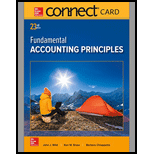
Concept explainers
Concept Introduction:
Costs assigned to Units transferred and units in ending inventory:
The costs are assigned to units transferred and units in ending inventory on the basis of equivalent units in materials and conversion and cost per units assigned.
The costs assigned to units transferred are calculated as under –
The costs assigned to ending inventory are calculated as under –
To assign:
Costs to the assembly department’s output for –
1. Units transferred out to painting department
2. Units in ending inventory (units that remain n process in the assembly department at month-end)
Answer to Problem 16QS
Solution:
Costs assigned for –
1. Units transferred out to painting department = $ 16,590
2. Units in ending inventory = $ 3,663
Explanation of Solution
The costs assigned to units transferred out to painting department and to units in ending inventory are calculated as under –
1. Costs assigned to units transferred out to painting department –
Given,
• Equivalent units for units transferred for materials = 7,000 units
• Equivalent units for units transferred for conversion = 7,000 units
• Cost per equivalent unit for materials = $ 1.02 per unit
• Cost per equivalent unit for conversion = $ 1.35 per unit
•
The costs assigned to units transferred out to painting department are = $ 16,590
2. Costs assigned to units that remain in assembly department (Ending inventory units) –
Given,
• Equivalent units for ending inventory for materials = 2,400 units
• Equivalent units for ending inventory for conversion = 900 units
• Cost per equivalent unit for materials = $ 1.02 per unit
• Cost per equivalent unit for conversion = $ 1.35 per unit
•
The costs assigned to units that remain in assembly department (Ending inventory units) are = $ 3,663.
Thus, the costs to the assembly department’s output for units transferred out to painting department and units in ending inventory (units that remain n process in the assembly department at month-end) have been assigned.
Want to see more full solutions like this?
Chapter 20 Solutions
Connect Access Card for Fundamental Accounting Principles
- I am trying to find the accurate solution to this financial accounting problem with appropriate explanations.arrow_forwardI need help finding the correct solution to this financial accounting problem with valid methods.arrow_forwardCan you help me solve this general accounting problem with the correct methodology?arrow_forward
- I need help with this financial accounting problem using proper accounting guidelines.arrow_forwardPlease provide the solution to this general accounting question using proper accounting principles.arrow_forwardI need help finding the accurate solution to this general accounting problem with valid methods.arrow_forward
- When incorporating his sole proprietorship, Joe transfers all of its assets and liabilities. Included in the $30,000 of liabilities assumed by the corporation is $500 that relates to a personal expenditure. Under these circumstances, the entire $30,000 will be treated as boot. / Provide explanation please a. True b. Falsearrow_forwardIn determining whether § 357(c) applies, assess whether the liabilities involved exceed the bases of all assets a shareholder transfers to the corporation./ Provide explanation please. a. True b. Falsearrow_forwardI will unhelpful if wrong.arrow_forward

 AccountingAccountingISBN:9781337272094Author:WARREN, Carl S., Reeve, James M., Duchac, Jonathan E.Publisher:Cengage Learning,
AccountingAccountingISBN:9781337272094Author:WARREN, Carl S., Reeve, James M., Duchac, Jonathan E.Publisher:Cengage Learning, Accounting Information SystemsAccountingISBN:9781337619202Author:Hall, James A.Publisher:Cengage Learning,
Accounting Information SystemsAccountingISBN:9781337619202Author:Hall, James A.Publisher:Cengage Learning, Horngren's Cost Accounting: A Managerial Emphasis...AccountingISBN:9780134475585Author:Srikant M. Datar, Madhav V. RajanPublisher:PEARSON
Horngren's Cost Accounting: A Managerial Emphasis...AccountingISBN:9780134475585Author:Srikant M. Datar, Madhav V. RajanPublisher:PEARSON Intermediate AccountingAccountingISBN:9781259722660Author:J. David Spiceland, Mark W. Nelson, Wayne M ThomasPublisher:McGraw-Hill Education
Intermediate AccountingAccountingISBN:9781259722660Author:J. David Spiceland, Mark W. Nelson, Wayne M ThomasPublisher:McGraw-Hill Education Financial and Managerial AccountingAccountingISBN:9781259726705Author:John J Wild, Ken W. Shaw, Barbara Chiappetta Fundamental Accounting PrinciplesPublisher:McGraw-Hill Education
Financial and Managerial AccountingAccountingISBN:9781259726705Author:John J Wild, Ken W. Shaw, Barbara Chiappetta Fundamental Accounting PrinciplesPublisher:McGraw-Hill Education





